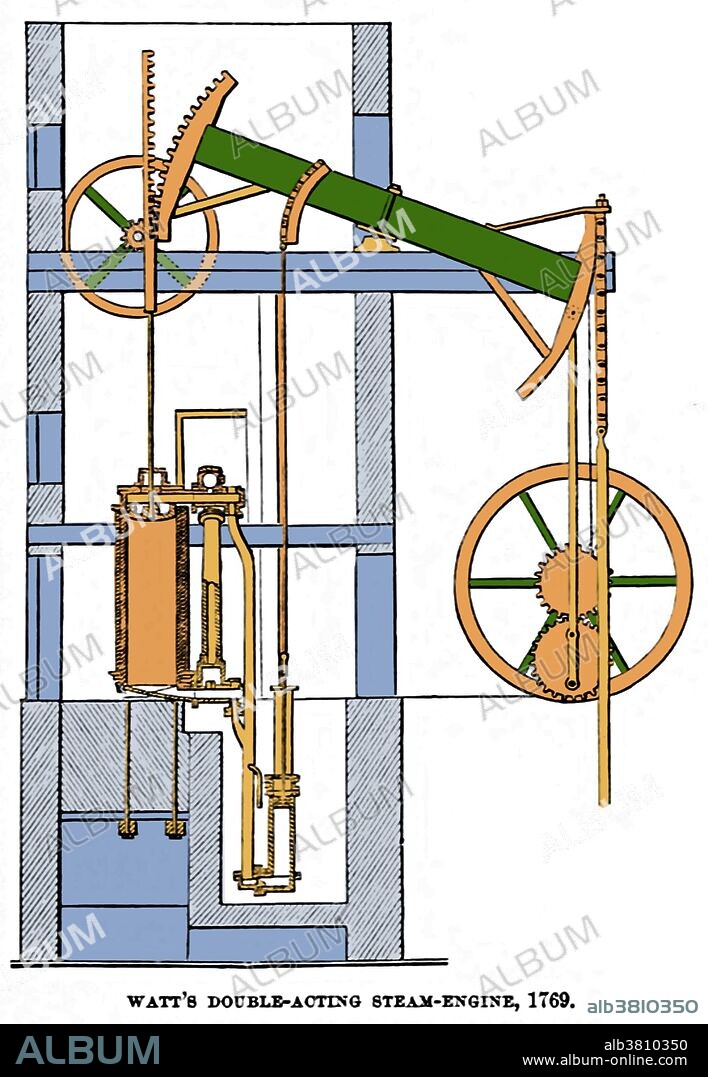alb3810350
James Watt, Double-Acting Steam Engine, 1769

|
Add to another lightbox |
|
Add to another lightbox |



Title:
James Watt, Double-Acting Steam Engine, 1769
Caption:
Watts' Double-acting steam engine illustration taken from page 47 of "The first century of the Republic. A review of American progress" by Theodore Dwight Woolsey, 1876. The Watt steam engine (alternatively known as the Boulton and Watt steam engine) was the first type of steam engine to make use of steam at a pressure just above atmospheric to drive the piston helped by a partial vacuum. Improving on the design of the 1712 Newcomen engine, the Watt steam engine, developed sporadically from 1763 to 1775, was the next great step in the development of the steam engine. Watt's two most important improvements were the separate condenser and rotary motion. The separate condenser, located external to the cylinder, condensed steam without cooling the piston and cylinder walls as did the internal spray in Newcomen's engine, more than doubling Watt's engine's efficiency. Rotary motion was more suitable for industrial power than the oscillating beam of Newcomen's engine. James Watt's design became synonymous with steam engines, due in no small part to his business partner, Matthew Boulton. In 1785, Watt was made a Fellow of the Royal Society. He developed the concept of horsepower and the SI unit of power, the watt, was named after him. He died in 1819 at the age of 83. Watt has been described as one of the most influential figures in human history. This image has been color enhanced.
Personalities:
Credit:
Album / Science Source / British Library
Releases:
Model: No - Property: No
Rights questions?
Rights questions?
Image size:
3000 x 4339 px | 37.2 MB
Print size:
25.4 x 36.7 cm | 10.0 x 14.5 in (300 dpi)
Keywords:
1769 • 18TH CENTURY • 18TH CENTURY, THE • 18TH • ART • ARTWORK • BRITISH • CELEBRITY • COLOR ENHANCED • COLOR ENHANCEMENT • COLOR • COLOR-ENHANCED • COLORIZATION • COLORIZED • DESIGN • DIAGRAM • DOUBLE ACTING ENGINE • DOUBLE ACTING STEAM ENGINE • DRAWING • ENERGIA • ENERGY • ENGINEER • ENGINEERING • EUROPEA • EUROPEAN • FAMOUS • FELLOW • HISTORIC • HISTORICAL • HISTORY • ILLUSTRATION • ILLUSTRATIONS • IMPORTANT • INDUSTRIAL REVOLUTION • INDUSTRIAL • INDUSTRY • INFLUENTIAL • INVENTION • INVENTOR (MALE) • INVENTOR • JAMES WATT • MECHANICAL ENGINEER • NOTABLE • ROYAL SOCIETY • SCIENCE • SCOTTISH • STEAM DRIVEN • STEAM ENGINE • STEAM POWERED • STEAM TURBINE • STEAM-DRIVEN • STEAM-ENGINE • STEAM-POWERED • STEAMENGINE • TECHNOLOGICAL • TECHNOLOGY • WATT • WELL-KNOWN
 Pinterest
Pinterest Twitter
Twitter Facebook
Facebook Copy link
Copy link Email
Email

